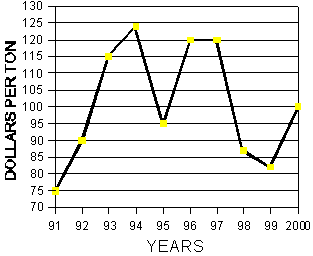Alfalfa Report
Yuma County, Arizona
December 4, 2000
Yuma County Office
2200 W. 28th Street, Ste. 102
Yuma, AZ 85364
(520) 726-3904
(520) 726-8472 FAX
Production Update:
PDF version, 14KB
Seedling Cold Damage: Alfalfa seedlings are thought to be the most sensitive to cold damage at the cotyledon stage before any true leaves have formed. While this may be the case under artificial conditions, in reality, the opposite seems to be true: alfalfa in the cotyledon stage is rarely damaged by cold. The temperature of the plant leaf during a cold night may be warmer than air temperature a few feet above the soil surface. A broad leaf near the soil surface may intercept heat from the soil and maintain a temperature above air temperature. We have observed seedling soybean, which is very frost sensitive, survive when air temperatures in the low 20s were reported.
Insect Management: Cowpea aphid (picture)
is a black aphid that has become a serious pest of new and established
stands of alfalfa. Western Arizona and southern California alfalfa stands
became heavily infested in November and this problem is expected to continue
into the spring months. When stands of alfalfa become heavily infested
with cowpea aphid, treatment with an insecticide may be warranted to prevent
yield loss due to stunting and leaf drop, and to prevent honeydew and
sooty mold contamination. Treatment thresholds have not been established
for cowpea aphid on alfalfa. Seedling alfalfa may be more susceptible
to damage from cowpea aphid.
Weed Control: Pursuit can be applied to seedling alfalfa and will
control a broad spectrum of broadleaf weeds. It will suppress but not
kill many grasses. Weeds that are not controlled include prickly lettuce,
sowthistle and lambsquarter. Stunting of seedling alfalfa will occur for
one cutting.
| Market Summary |
High
|
Low
|
Average
|
Off grade
|
| Past 2 Weeks (Nov. 21 to Dec. 4, 2000) |
105
|
90
|
100
|
70-90
|
| Last Year (Nov. 21 to Dec. 4, 1999) |
85
|
75
|
82
|
60-75
|
10 Year Summary (November 21, to December 4, 1991-2000):

Issued in furtherance of Cooperative Extension work, acts of May 8 and June 30, 1914, in cooperation with the U.S. Department of Agriculture, James A. Christenson, Director Cooperative Extension, College of Agriculture and Life Sciences, The University of Arizona.
The University of Arizona is an equal opportunity, affirmative action institution. The University does not discriminate on the basis of race, color, religion, sex, national origin, age, disability, veteran status, or sexual orientation in its programs and activities.
Any products, services, or organizations that are
mentioned, shown, or indirectly implied in this web document do not imply
endorsement by The University of Arizona.
Information provided by:
Barry Tickes, btickes@ag.arizona.edu Extension Agent, Yuma County
Michael Ottman, mottman@ag.arizona.edu Agronomy Specialist
College of Agriculture, The University of Arizona.
Eric Natwick, etnatwick@ucdavis.edu UCCE Imperial County - Farm Advisor
University of California, Davis, CA.
Material written December 4, 2000.
Forages: Crop Mgmt | Soil Mgmt | Irrigation | Alfalfa Reports | Insects | Diseases | Weeds | Pesticides
Home | Other Crops | Forages
For more Arizona Production Ag Information:
Home | Cotton | Veggies| Forages | Grains | Citrus | Crop x Crop | Insects | Diseases| Weeds | Pesticides | News | Weather | Research | Photos | Contacts | General Info. | Site Map
Copyright © 2001 University of Arizona,
College of Agriculture and Life Sciences
Webmaster: Al Fournier (fournier@ag.arizona.edu)